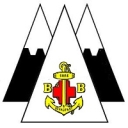Skiddaw - 931 m (3,054 ft)
Skiddaw is the 6th highest peak in England and dominates the skyline to the north of the town of Keswick, from where there is an easy ascent via a tourist track. The mountain is a long undulating ridge aligned roughly north-south with steep drops east and west. Its surface is mainly grassy, but the summit is littered with small slaty stones. Along the ridge, to the south of the main peak, is another Hewitt, called Little Man. The main summit is sometimes known as High Man or Skiddaw Man. The latter appears on Ordnance Survey maps as the name of the summit.
See its entries on Walkhighlands or Wikipedia or view it from above on Google Earth.
The earliest references to Skiddaw, in the 13th century, spelt it as Skythou and Skydehow. The name could be derived from Old Norse words Skyti meaning Archer or Skut meaning Jutting Crag and Haugr meaning Hill (but commonly corrupted to How or Howe in English mountain names). An alternative is that
Man, as in Skiddaw Man, might come from Mœna (Old Norse) meaning something which comes to a point or projects out (i.e. a Peak) or from the Cumbric equivalent of Maen (Welsh), meaning Stone or Mann (Old English) simply meaning Man.
Published on





